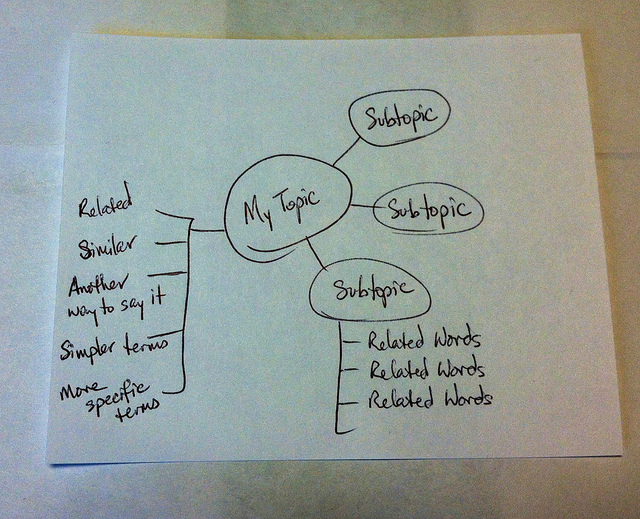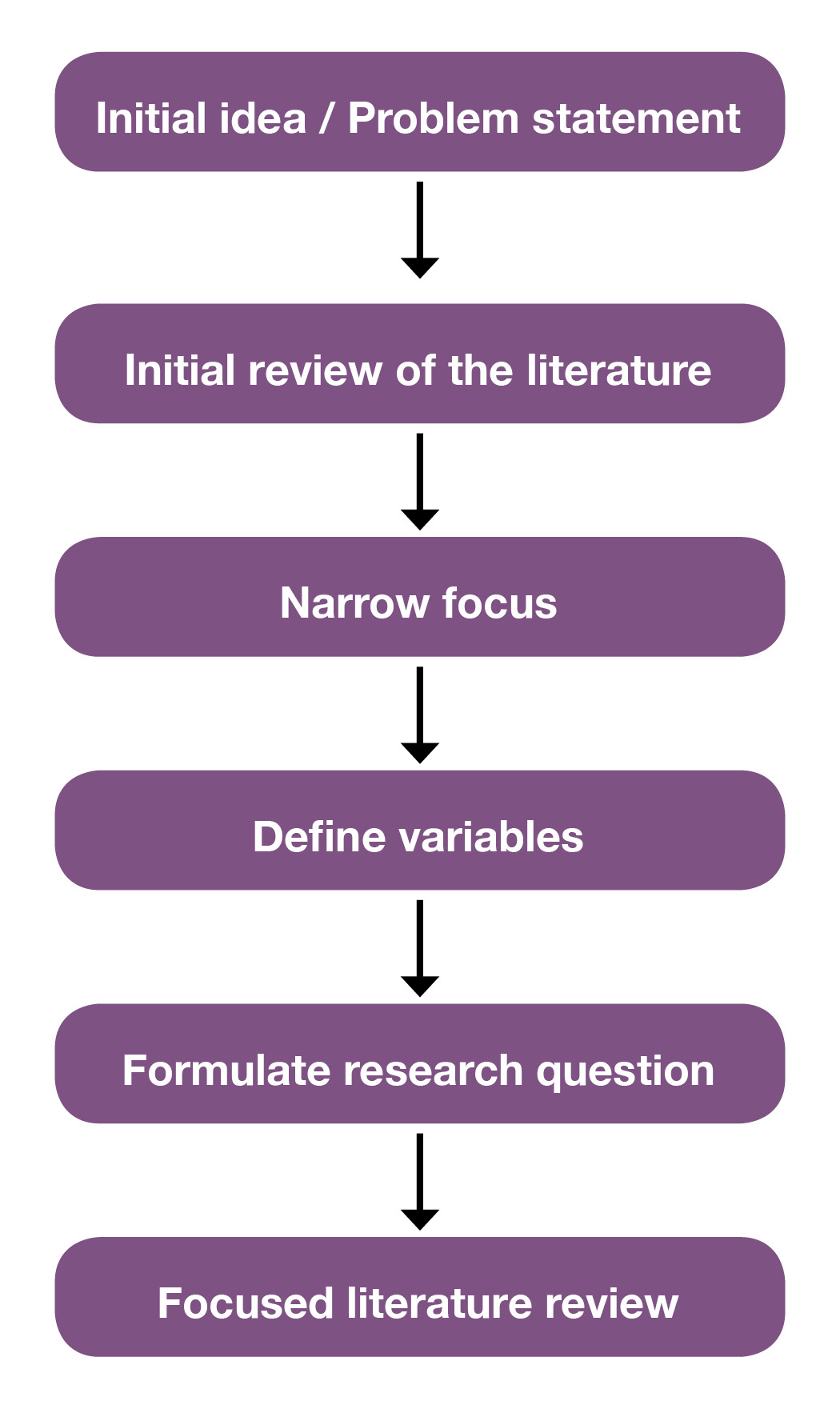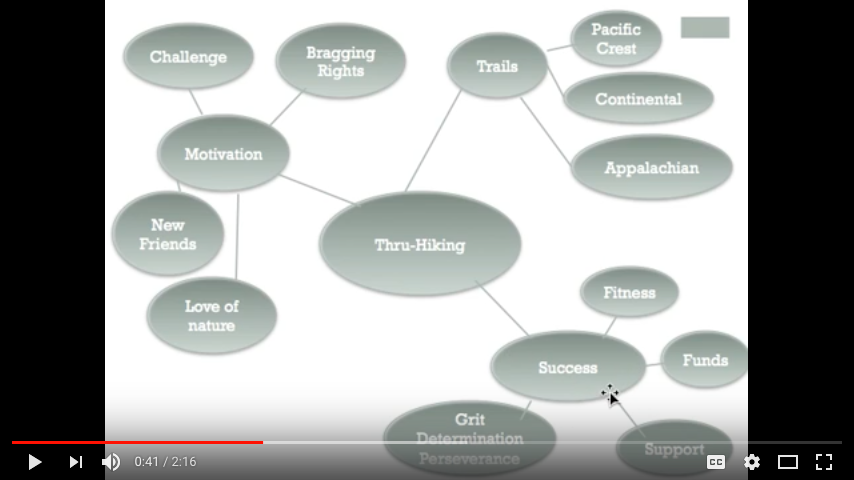Chapter 3: How to Get Started
Learning Objectives
At the conclusion of this chapter, you will be able to:
- Develop and refine a viable research question for your literature review
3.1 Topic selection
If the longest journey begins with the first step, most graduate-level literature reviews begin with choosing a relevant, appropriate, interesting topic about which to do the review. Whether the topic is assigned, chosen from a list of possible options, or (most likely) developed on your own, a good way to begin your thinking is to take a general issue or subject and formulate it into a question. You may want to start to think about a single aspect in your field or discipline that might be interesting to pursue, such as ‘science education’ or ‘diabetes treatment.’
A good topic selection plan begins with a general orientation into the subject you are interested in pursuing in more depth. Although finding a good research question may initially feel like looking for a needle in a haystack, choosing a general topic is the first step.
Things to think about when choosing a topic area:
- Pick an area of interest; pick an area of experience; or, pick an area where you know there is a need for more research.
- It may be easier to start with “what” and “why” questions and expand on those. For example, in Nursing: what is current research on obesity and why is it significant to nursing and health sciences? Or, in Education: what is media literacy and why is it significant to education sciences?
- If you are a teacher or other education practitioner, you might think about a current problem in the workplace such as, classroom management or parent interaction and expand from there. Nurses may want to consider a current issue in a clinical or hospital setting, like hand washing or patient falls.
Other suggestions for choosing a topic include:
- Ask a professor, preferably one active in research, about possible topics
- Read departmental information on research interests of the faculty. Faculty research interests areas vary widely, so do some research on their past publications. Most departmental websites post faculty CVs.
- Read a research paper that interests you. The paper’s literature review or background section will provide insight into the research question the author was seeking to address with his/her study. Is the research incomplete, imprecise, biased, or inconsistent? As you’re reading the paper, look for what’s missing. These may be “gaps in the literature” that you might explore in your own study. The conclusion or discussion section at the end may also offer some questions for future exploration. A recent blog posting in Science (Pain, 2016) provides several tips from researchers and graduate students on how to effectively read these papers.
- Think about papers you enjoyed researching and writing as an undergraduate and choose a topic that reflects those interests
- Sift through the table of contents of annual reviews journals in your area of interest – such as, the Annual Review of Psychology, the Annual Review of Immunology, the Review of Research in Education, or the Annual Review of Nursing Research.
- Identify and browse journals related to your research interests. Faculty and librarians can help you identify relevant journals in your field and specific areas of interest.
Although it’s a good idea to avoid subjects that are too personal or emotional as these can interfere with an unbiased approach to the research, it’s also important to make sure you have more than a passing interest in the topic. You will be with this literature review for an extended period of time and it will be difficult to stick with it even under the best circumstances. A graduate student in psychology said, “‘My advice would be to NOT choose a topic that is an unappealing offshoot of your adviser’s work or a project that you have lukewarm feelings about in general…It’s important to remember that this is a marathon, not a sprint, and lukewarm feelings can turn cold quickly.’” (Dittman, 2005).
3.2 Question formulation
Now, take that general idea and begin to think about it in terms of a question. What do you really want to know about the topic? As a warm-up exercise, try dropping a possible topic idea into one of the blank spaces below. The questions may help bring your subject into sharper focus and provide you with the first important steps towards developing your topic. The type of paper you want to write (Definition, Analysis, Narration, etc.) can also be a useful way to begin thinking about your research question. For example, if you’re interested in parent involvement in early childhood education, your research question might be “What are the various features of parent involvement in early childhood education?” Or, if you want to do an evaluative literature review, your research question could be “What is the value of infant vaccination?”
- What does ___ mean? (Definition)
- What are the various features of ___? (Description)
- What are the component parts of ___? (Simple analysis)
- How is ___ made or done? (Process analysis)
- How should ___ by made or done? (Directional analysis)
- What is the essential function of ___? (Functional analysis)
- What are the causes of ___? (Causal analysis)
- What are the consequences of ___? (Causal analysis)
- What are the types of ___? (Classification)
- How is ___ like or unlike ___? (Comparison)
- What is the present status of ___? (Comparison)
- What is the significance of ___? (Interpretation)
- What are the facts about ___? (Reportage)
- How did ___ happen? (Narration)
- What kind of person is ___? (Characterization/Profile)
- What is the value of ___? (Evaluation)
- What are the essential major points or features of ___? (Summary)
- What case can be made for or against ___? (Persuasion)
- What is the relationship between _____ and the outcome of ____? (Explorative)
For more information about how to form a research question, check out this video tutorial:
At this point, you will want to do an initial review of the existing literature to see what resources on your topic or question already exist. Based on what you find, you may decide to alter your question in some way before going too far along a path that perhaps has already been well-covered by other scholars.
3.3 Research Question or Hypothesis?
Some things to keep in mind at this beginning stage of the research process is whether your literature review will be in the form of a research question or a hypothesis. One way to determine that outcome is to compare the two and decide which format will work best for you. For example, if the area you are researching is a relatively new field, and there is little or no existing literature or theory that indicates what you will find, then your literature review will likely be based on a research question.
3.3.1 Research question criteria:
The question should express a relationship between two or more variables – for example, how is A related to B? It should be clearly stated in a question form – such as, “How do grades (A) affect participation in class (B)?” or “How does parental education level (A) affect children’s vaccination status (B)?” Your literature review, in turn, may become:
Grades as a classroom participation motivator: A literature review, or
Education level and vaccinations: A literature review
Your question should also imply possibilities for empirical testing–remember, metaphysical questions are not measurable and a variable that cannot be clearly defined cannot be tested.
3.3.2 Hypothesis criteria:
If, however, your literature review tests something based on the findings of a large amount of previous literature or a well-developed theory, your literature review will be to test of a hypothesis, rather than answer a question. The statement should indicate an expected relationship between variables and it must be testable. State your hypothesis as simply and concisely as possible. For example, if A, then B, as in: “If patient is obese, he/she will also be deaf.” (Dhanda & Taheri, 2017). Or, “For those who stutter, unusual temperament or anxiety is a causal factor.” (Kefalianos, 2012)
| Research Question | Hypothesis |
| Is A related to B? | If A, then B |
| How are A and B related to C? | If A & B, then C |
| How is A related to B under conditions C and D? | If A, then B under conditions C and D |
Decide what type of relationship you would like to study between the variables. Now, try to express the relationship between the concepts as a single sentence–in the form of either a research question or a hypothesis.
3.4 Refining the question
Once you have selected your topic area and reviewed literature related to it, you may need to narrow it to something that can be realistically researched and answered. In addition to asking Who, What, When, Where, Why, and How questions, other types of questions you might begin to ask to further refine your topic include those that are: Descriptive, Differential or Comparative, Associative or Relational.
You might beginning by asking a series of PICO questions. Although the PICO method is used primarily in the health sciences, it can also be useful for narrowing/refining a research question in the social sciences as well. A way to formulate an answerable question using the PICO model could look something like this:
- Patient, Population or Problem: What are the characteristics of the patient or population? For example, gender, age, other demographics. What is the situation or disease you are interested in? For example, diabetes or classroom management
- Intervention or exposure: What do you want to do with the patient, person, or population (e.g. treat, diagnose, observe)? Such as, observe classroom behavior or reaction to a specific type of treatment
- Comparison: What is the alternative to the intervention (e.g. placebo, different drug, surgery)? For example, how does a sample group that is assigned homework compare to a similar group that is not assigned homework?
- Outcome: What are the relevant outcomes (e.g. morbidity, death, complications)? For example, how do lower cholesterol numbers or improved scores in spelling impact the target population?
Some examples of how the PICO method is used to refine a research question include:
- Education: “Is play-based learning an effective approach in early childhood education? – Population (early childhood) / Intervention (play-based learning),” or “Can music therapy help autistic students improve their communication skills? – Population (autistic students / intervention (music therapy)”
- Nursing: “What is the effect of a dressing with silver in its composition on the treatment of diabetic foot ulcers? – Population (patients with diabetes) / Intervention (dressings made with silver)” or “How effective are antidepressive medications on anxiety and depression? – Intervention (antidepressants) / Population (patients with anxiety and depression)”
Another mnemonic technique used in the social sciences for narrowing a topic is SPICE. An example of how SPICE factors can be used to develop a research question is given below:
Setting – for example, Canada
Perspective – for example, Adolescents
Intervention – for example, Text message reminders
Comparisons – for example, Telephone message reminders
Evaluation – for example, Number of homework assignments turned in after text message reminder compared to the number of assignments turned in after a telephone reminder
Likewise, developing a concept map or mind map around your topic may help you analyze your question and determine more precisely what you want to research. Using this technique, start with the broad topic, issue, or problem, and begin writing down all the words, phrases and ideas related to that topic that come to mind and then ‘map’ them to the original idea.

This mapping technique aims to improve the “description of the breadth and depth of literature in a domain of inquiry. It also facilitates identification of the number and nature of studies underpinning mapped relationships among concepts, thus laying the groundwork for systematic research reviews and meta-analyses.” (Lesley, Floyd, & Oermann, 2002; D’Antoni & Pinto Zipp, G., 2006). Its purpose, like the other methods of question refining, is to help you organize, prioritize, and integrate material into a workable research area; one that is interesting, answerable, realistic in terms of resource availability and time management, objective, scholarly, original, and clear.
Check out this YouTube video for more basic information on how to map your research question:
In addition to helping you get started with your own literature review, the techniques described here will give you some keywords and concepts that will be useful when you begin searching the literature for relevant studies and publications on your topic.

For example, perhaps your initial idea or interest is ‘how to prevent obesity.’ After an initial search of the relevant nursing literature, you realize the topic of ‘obesity’ is too broad to adequately cover in the time you have to do your literature review. You decide to narrow your focus to ‘causes of childhood obesity.’ Using PICO factors you further narrow your search to ‘the influence of family factors on overweight children.’ A potential research question might then be “What maternal factors are associated with toddler obesity in the United States?” You’re now ready to begin searching the literature for studies, reports, cases, and other information sources that relate to this question.
Similarly, for a broad topic like ‘school performance’ or ‘grades,’ and after an initial literature search that provides some variables, examples of a narrow research question might be:
- “To what extent does parental involvement in children’s education relate to school performance over the course of the early grades?”
- “Do parental involvement levels differ by family social, demographic, and contextual characteristics?”
- “ What forms of parent involvement are most highly correlated with children’s outcomes? What factors might influence the extent of parental involvement?” (Early Childhood Longitudinal Program, 2011).
Practice
Take a general topic such as “Reading Comprehension” or “Hospital Falls” and identify a slightly more narrow concept by using the questions provided in the worksheet.
- Next refine your topic further by choosing one of the PICO factors
- Now practice writing your topic as a research question or hypothesis
- Is your question or hypothesis interesting, answerable, and clear? Ask a classmate to read your question or hypothesis and explain to you what the research will be.
Good question? | Bad question? | Why?
Each of the questions below has advantages and disadvantages. Based on some of the criteria for formulating a research question discussed in this section, which of the following questions seems the most viable for further study and why? See the Answer Key for the correct responses
- Education: Do adult learners in a rural adult education setting have characteristics that are similar to adult learners in general
- Education: What are the characteristics of rural adult learners in an adult education program?
- Education: How does the U.S. Department of Education serve rural learners?
Look at these recent publications in the literature for nursing and education. Can you spot the research question? Which PICO factors were used in each example?
- Nursing: Workplace Hazards Faced by Nursing Assistants in the United States: A Focused Literature Review. (Walton, A., & Rogers, B., 2017).
- Nursing: What are the family needs when a parent has mental health problems? Evidence from a systematic literature review. (Wahl, et al., 2017).
- Education: Music in Peacebuilding: A Critical Literature Review (Sandoval, 2016).
- Nursing: Health literacy programs for older adults: A systematic literature review (Manafo & Wong, 2012).
- Education: English language learners and reading instruction: A review of the literature. (Snyder, Witmer, & Schmitt, 2017).
- Nursing: Cultural interventions to treat addictions in indigenous populations: Findings from a scoping study. (Rowan et al, 2014).
Test Yourself
See the Answer Key for the correct response.
Question 1: This is an effective research question: Do school breakfast programs in Washington and Oregon differ? Choose True or False
- True
False
Question 2. Which of the two questions below is more effective? Choose A or B
- Are females smarter than males?
- Do females aged 18-36 score higher on the Graduate Record Exam than adult males between the ages of 18-35?
Question 3. Which of the following research question is more effective? Choose A or B
- Five methods of assessing nursing students’ critical thinking skills within the context of clinical practice are: 1) Observation, 2) Questions, 3) Conferences, 4) Problem-solving strategies, and 5) written assignments. The literature is reviewed on each of these methods.
- Critical thinking is an important competency needed by nursing students. Varied methods can be used for assessing critical thinking.
Question 4. This is the research question: What impact has the No Child Left Behind (NCLB) program had on high school graduation rates?
What information sources will I need to find to begin my literature review? Choose A, B, C, or D.
- statistics on graduation rates before and after the program went into effect
- statistics on the success or failure of other retention programs
- information about government education programs before and after the era of NCLB
- all of the above
Question 5. Is the scope of this information reasonable:
I will review 30 online nursing training programs developed over a span of 10 years? Choose Yes or No
Yes or No
Question 6. PICO questions are a good way to narrow your research focus. What does PICO mean? Choose 1, 2, 3, or 4
- Parents, Intermediaries, Corporations, Oscillations
- Populations, Interventions, Comparisons, Outcomes
- Problems, Instruments, Channels, Operations
- Patients, Interference, Courses, Origins



